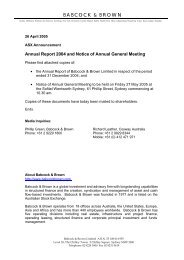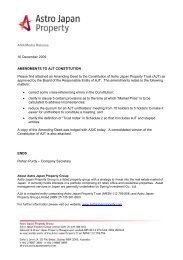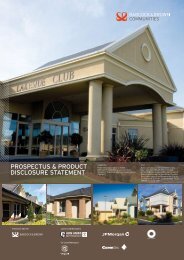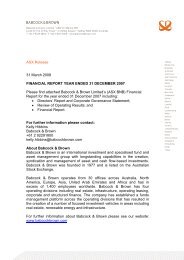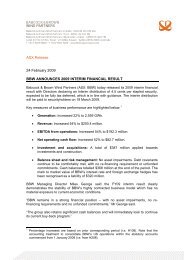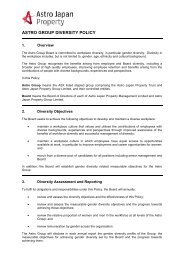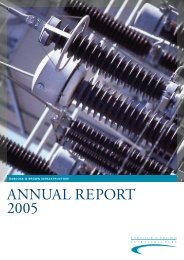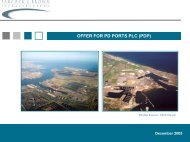Lead Manager
babcock & brown limited prospectus.pdf - Astrojapanproperty.com
babcock & brown limited prospectus.pdf - Astrojapanproperty.com
- No tags were found...
You also want an ePaper? Increase the reach of your titles
YUMPU automatically turns print PDFs into web optimized ePapers that Google loves.
BABCOCK & BROWN PROSPECTUS<br />
Management discussion and analysis<br />
Historicals<br />
2003 compared with 2002<br />
Net Revenues increased 21.4% from $69.5 million to $84.4 million primarily due to significant increases in the<br />
European and UK PFI businesses outweighing declines in Net Revenue from the Australian and US businesses.<br />
An increase in Net Revenue in the Asian business also contributed to overall Net Revenue growth.<br />
The European business’ Net Revenue growth was principally driven by gains from principal investments in an<br />
offshore windfarm in the UK and fees and interest from a corporate bridge loan it provided in respect of a major<br />
European paper mill project for which Babcock & Brown acted as financial advisor.<br />
UK PFI’s Net Revenues were driven primarily by profit on the sale of the Group’s 50% interest in a secondary<br />
portfolio of 18 UK-based infrastructure projects and by leveraging equity cash flows on the portfolio of PFI<br />
projects developed by the Group to that point in time.This profit coupled with continued success in generating<br />
advisory and development fees from new projects underpinned a very successful year for this business.<br />
Revenues in the Australian business declined from record levels in 2002 when returns from the listing of Prime<br />
Infrastructure had a disproportionately positive impact on revenues (see further discussion of this in the discussion<br />
of 2002 versus 2001 below). 2003 revenues in Australia were, however, still materially higher than in 2001,<br />
continuing a very positive growth trend.<br />
The US business was exclusively an advisory business until the beginning of 2002. In 2001 and prior years it was<br />
a leading advisor in the power sector helping structure plant-acquisition financings for large US power companies<br />
as they aggressively expanded their generation capacity.This activity was significantly curtailed in 2002 due to<br />
significant overcapacity in the US power sector and the Enron bankruptcy. In response, the business began to<br />
diversify its activities in 2002, completing its first wind development in that year. In 2003, the US business<br />
concentrated its efforts on building its development capabilities and had closed three wind development<br />
transactions by the end of the year.The revenues from this development activity did not fully compensate for the<br />
lower level of advisory business during the year and hence revenues declined from 2002 to 2003.<br />
2002 compared with 2001<br />
Revenues increased 62.5% from $42.7 million to $69.5 million primarily due to increases in revenues<br />
from the Australian and US businesses, which accounted for almost 85% of overall Infrastructure and Project<br />
Finance revenues.<br />
The Australian Infrastructure and Project Finance business had a record year in 2002. Revenues from the<br />
listing of Prime Infrastructure and the partial realisation of the Group’s investment in the DBCT were the<br />
major revenue contributors during the year.<br />
The increase in the US business’ revenues was driven principally by advisory fees with respect to<br />
merger-and-acquisition activity involving large power stations. Fees and profits were also derived from the<br />
Group’s role as advisor and co-developer of the Cabazon wind farm, the Group’s first foray into principal<br />
investing activity in the US wind sector.<br />
The European business continued the progress achieved during 2001 under a consolidated pan-European<br />
management structure and increased revenues by approximately 90% during the year.The Asian business made<br />
a small revenue contribution in 2002 in its first full year of operation.<br />
The UK PFI business’ revenue declined mainly as a consequence of delays in projects achieving financial close<br />
as well as equity-accounting losses generated from the Group’s 50% holding in a secondary market portfolio of<br />
18 PFI projects, which was subsequently sold for a significant profit in 2003.<br />
63



